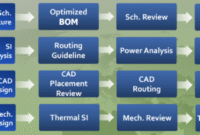Product Innovation Trends in the Hardware Sector are redefining the landscape of technology, creating exciting opportunities for businesses and consumers alike. As we delve into this dynamic field, we’ll explore how emerging technologies, shifting consumer demands, and sustainability concerns influence product development in hardware. This overview will not only highlight the latest trends but also provide insights into how companies can thrive in this competitive environment.
In today’s fast-paced world, effective communication has become more crucial than ever. Whether you’re sending an email, giving a presentation, or simply chatting with a colleague, the way we articulate our thoughts can greatly influence our personal and professional relationships. In this article, we’ll explore the significance of communication, the various forms it takes, and tips for improving your communication skills.
The Importance of Communication
Communication is the foundation of human interaction. It empowers us to express our thoughts, share ideas, and build connections with others. In a professional setting, effective communication can lead to better teamwork, improved productivity, and enhanced relationships among colleagues. For instance, when team members communicate openly about their projects, they can collaborate more efficiently and resolve conflicts more swiftly.
Furthermore, effective communication plays a significant role in decision-making processes. When information is conveyed clearly and concisely, it helps individuals make informed choices, leading to better outcomes for organizations. On the other hand, poor communication can result in misunderstandings, confusion, and mistakes, ultimately harming productivity and morale.
Forms of Communication
Communication can be categorized into several forms: verbal, non-verbal, written, and visual. Each type has its unique characteristics and uses.
1. Verbal Communication: This refers to the spoken exchange of information. It can take place in one-on-one conversations, meetings, or presentations. Verbal communication is often spontaneous and can convey emotions and tone, making it a powerful tool for building rapport.
2. Non-Verbal Communication: Body language, facial expressions, gestures, and eye contact all fall under non-verbal communication. These cues often accompany verbal communication and can enhance or contradict the spoken message. For example, crossing your arms might signal defensiveness, while maintaining eye contact can show confidence and engagement.
3. Written Communication: This includes emails, reports, memos, and any other form of text-based communication. Written communication is essential in the business world, as it provides a permanent record of information and can be reviewed at any time. However, it lacks the immediate feedback and emotional nuances present in verbal communication.
4. Visual Communication: This form encompasses images, graphs, charts, and other visual aids. Visuals can help convey complex information quickly and clearly, making them invaluable in presentations and reports. For instance, a well-designed graph can illustrate trends that would take several paragraphs to explain in writing.
Improving Communication Skills
Now that we’ve established the importance of communication and its various forms, let’s delve into some practical tips for enhancing your communication skills.
1. Active Listening: One of the most vital components of effective communication is listening. Practicing active listening involves fully concentrating on what the speaker is saying, rather than merely waiting for your turn to speak. Show that you’re engaged by nodding, making eye contact, and summarizing what the speaker has said. This demonstrates respect for their perspective and encourages open dialogue.
2. Be Clear and Concise: Whether you’re speaking or writing, clarity is key. Avoid jargon and overly complex language that might confuse your audience. Instead, aim for simplicity while conveying your message. For instance, when delivering a presentation, break down your points into manageable segments and use bullet points to enhance readability.
3. Tailor Your Message: Different audiences have different needs and preferences. When communicating, consider who your audience is and adjust your message accordingly. For example, a technical report for engineers will differ significantly from a summary for non-technical stakeholders. Understanding your audience will help you craft a message that resonates with them.
4. Practice Empathy: Empathy is the ability to understand and share the feelings of others. When communicating, try to put yourself in the other person’s shoes. This can help you respond more thoughtfully and build stronger relationships. Empathetic communication fosters trust and collaboration, which are essential in both personal and professional environments.
5. Use Feedback: Constructive feedback is a valuable tool for improving communication. Encourage your colleagues and peers to provide feedback on your communication style and effectiveness. Be open to criticism and use it as an opportunity for growth. Additionally, don’t hesitate to ask for clarification if you receive feedback that is unclear or seems unjustified.
6. Non-Verbal Awareness: As mentioned earlier, non-verbal communication plays a significant role in how messages are received. Be mindful of your body language and facial expressions, as they can convey messages just as powerfully as words. Similarly, pay attention to the non-verbal cues of others, as they can provide insight into how your message is being received.
7. Utilize Technology Wisely: In the digital age, technology has transformed how we communicate. While tools like email and messaging apps facilitate quick communication, they can also lead to misunderstandings if not used carefully. Be mindful of your tone in written communication, as it can be easily misinterpreted. Additionally, when using visual aids, ensure they are clear and relevant to your message.
8. Enhance Your Vocabulary: A rich vocabulary can help you express your ideas more effectively. Make it a habit to learn new words and phrases to enhance your communication. However, avoid using overly complex words that might alienate your audience. The goal is to communicate your ideas clearly, not to impress with your vocabulary.
9. Seek Professional Development: Consider enrolling in communication workshops or courses to further hone your skills. Many organizations offer training programs that focus on effective communication, negotiation, and public speaking. Investing in your professional development can yield significant dividends in your career.
10. Reflect and Adapt: After any communication, take a moment to reflect on what went well and what could be improved. Consider keeping a journal to track your progress and note any challenges you encounter. This reflective practice can help you adapt your approach and become a more effective communicator over time.
The Impact of Effective Communication on Relationships
Effective communication is not only essential in professional settings but also crucial in personal relationships. When we communicate openly and honestly with our loved ones, we build trust and deepen our connections. Conversely, poor communication can lead to misunderstandings and conflict.
For instance, expressing your feelings and thoughts clearly with a partner can prevent resentment from building up. When both parties feel heard and understood, it fosters a healthy relationship dynamic. Additionally, open communication can help resolve conflicts more efficiently, as both individuals can express their viewpoints and work towards a mutually agreeable solution.
In friendships, effective communication can help navigate challenges and strengthen bonds. Friends who communicate openly can support each other during difficult times, celebrate successes, and share experiences. This mutual understanding creates a solid foundation for lasting friendships.
Conclusion
In summary, effective communication is a vital skill that can enhance both personal and professional relationships. By understanding the importance of communication and the various forms it takes, we can work towards improving our communication skills. Practicing active listening, being clear and concise, tailoring our messages, and demonstrating empathy are just a few steps we can take to become better communicators.
As we navigate the complexities of both our personal and professional lives, let’s remember that good communication fosters understanding, collaboration, and connection. Investing time and effort into improving our communication skills will undoubtedly pay off in the long run.
In conclusion, the exploration of Product Innovation Trends in the Hardware Sector reveals a vibrant and rapidly evolving market. As companies adapt to new technologies and consumer preferences, the potential for groundbreaking advancements is immense. Businesses that embrace these trends will not only enhance their product offerings but also meet the evolving expectations of consumers, paving the way for a brighter future in hardware innovation.
FAQ Insights: Product Innovation Trends In The Hardware Sector
What are the key drivers of product innovation in the hardware sector?
The key drivers include emerging technologies, consumer demands, sustainability concerns, and competitive pressures.
How can companies stay ahead in product innovation?
Companies can stay ahead by investing in research and development, leveraging customer feedback, and continuously monitoring market trends.
What role does sustainability play in hardware innovation?
Sustainability is crucial as consumers increasingly prefer eco-friendly products, prompting companies to innovate in materials and processes.
Are there specific technologies influencing hardware innovation?
Yes, technologies such as AI, IoT, and advanced manufacturing processes are significantly influencing hardware innovation.
What future trends should we watch in the hardware sector?
Future trends include increased integration of AI, the rise of smart devices, and a focus on modular designs for easier upgrades.



